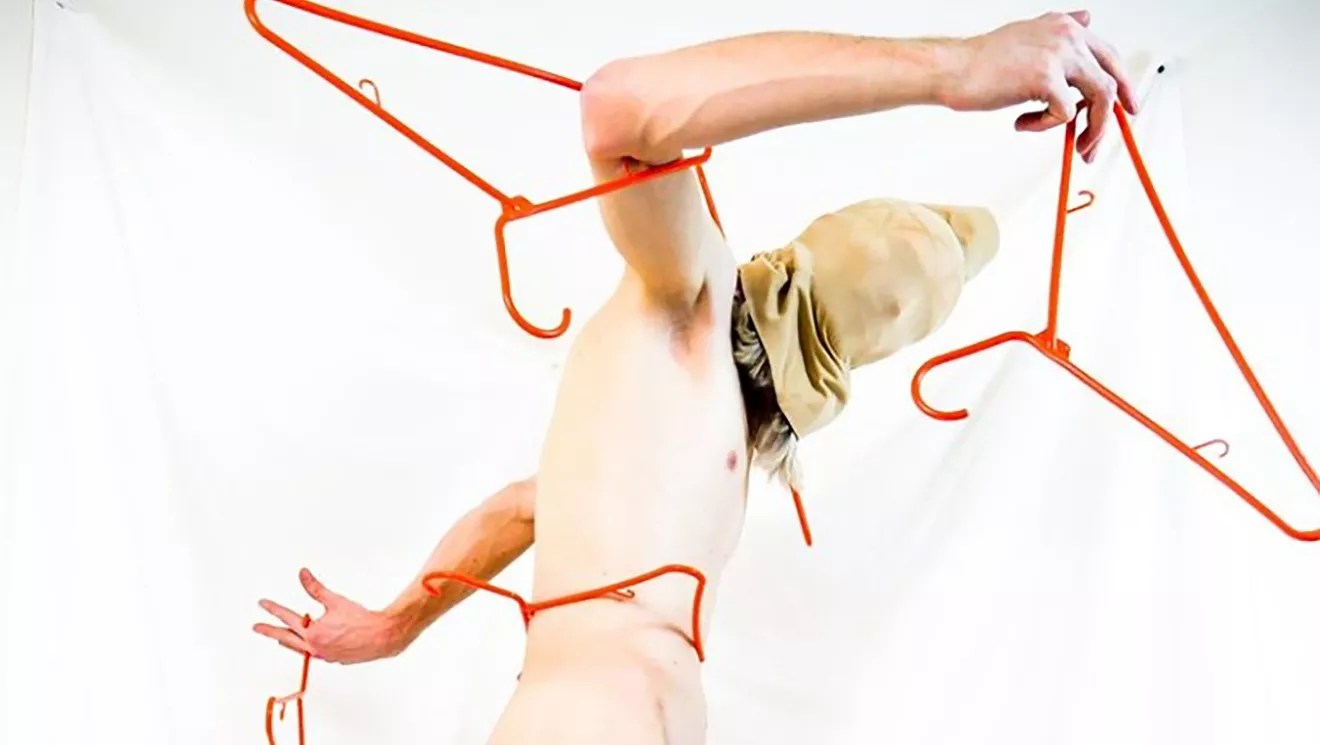
Courtesy Viera Smith

Audio By Carbonatix
Viera Smith’s partner, NÁ¯r, is scribbling poetry on the walls of Smith’s house near West Colfax Avenue and Xavier Street. Meanwhile, artist Pax Transwitch is covering the basement floor with sand. “There’s also going to be a tent and war sounds and blood on the ground,” Smith says.
The house has become a completely immersive environment, where the art is meant to be touched and even heard. Some works spill out from one room into another. “We’re essentially putting things everywhere,” Smith explains. “We have people putting stuff in closets, bathrooms, you name it – any space we could find, we’re trying to use.”
Nineteen artists, including Smith, have been installing unique, stimulating works throughout her home for Denver art collective Below the Concrete’s sophomore show, Natural Tensions: Between Sanctuary and Conflict.
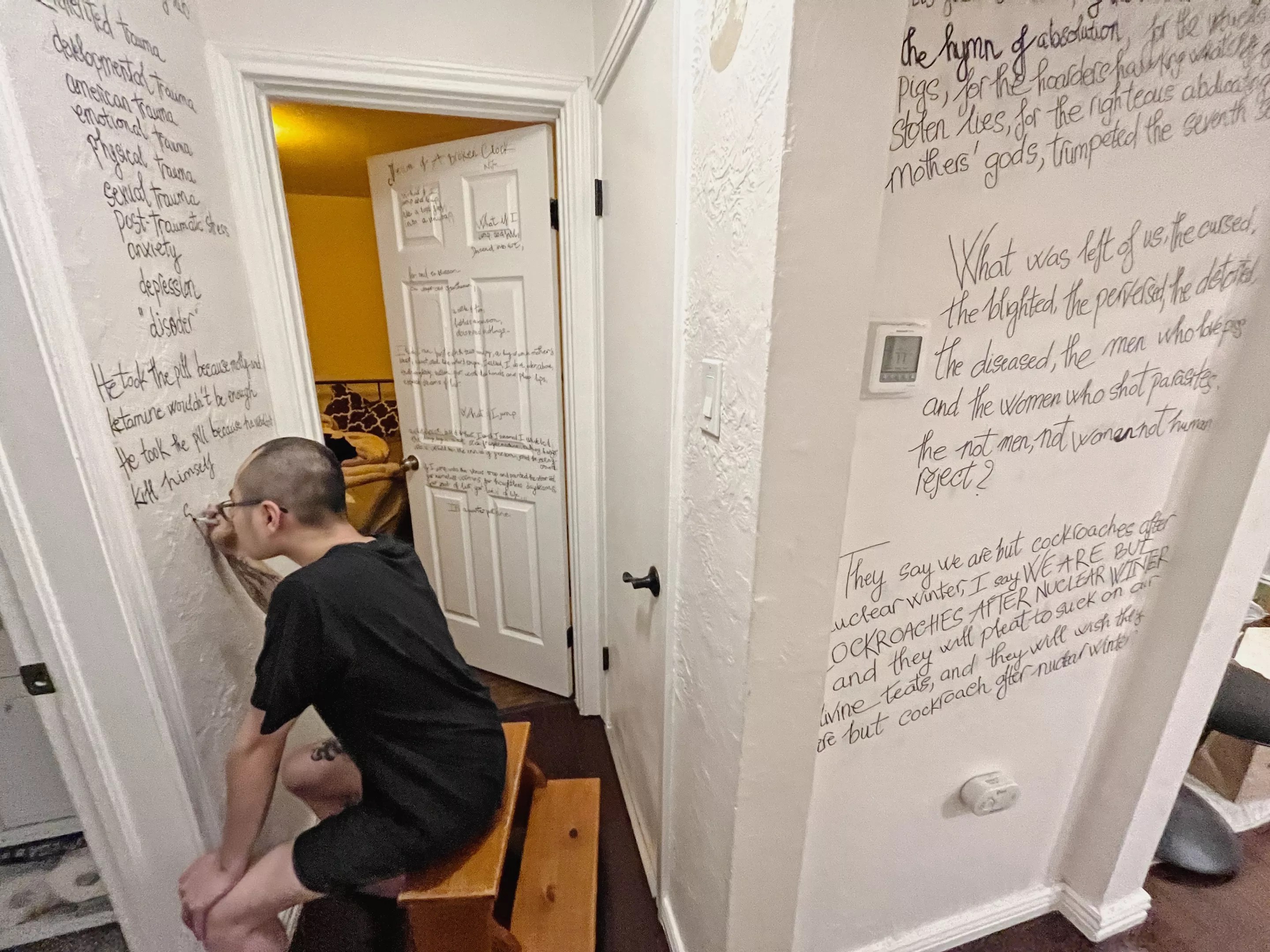
Nïr is seen writing poetry on the walls.
Courtesy Viera Smith
Made up entirely of transgender and queer artists, Below the Concrete formed in response to a “distinct lack of opportunities, especially for transgender artists,” Smith says. “We wanted to create that space and opportunities for ourselves.”
The collective’s name is a reference to breaking through societal expectations and forging a path where queer artists can express themselves authentically. “We’re kind of considering the broad idea of concrete as modern society, modern technology – the idea of the concrete jungle,” Smith explains. “And by asserting that we’re below the concrete, we’re exploring universal but subversive ideas, especially within our own community, which is not mainstream at this point. It’s this mission of representing ourselves.”
Smith moved to Denver last year after working as a stylist in New York for more than a decade. “The art scene [in New York] is very inspiring, very cool, but it’s a little closed off and cliquey,” Smith says. “Here, I’ve just seen a more open community, and it’s been easier to connect with people.”
In Denver, Smith met Kit Bollag-Miller, who began conceptualizing a queer, DIY house show with her roommate last winter after moving up from Colorado Springs. “We had moved to Denver sort of recently, and we wanted to start to build our community, and we had met a bunch of queer artists already,” Bollag-Miller recalls. “We tossed around the idea of opening our apartment up to putting on a free show that anyone could come to. The original thought was to break down the idea of a traditional art space, which is inaccessible for a lot of people, and expensive. We just were interested in putting on these art shows in unconventional art spaces and also using it as a tool to build community and an art collective. That’s where Below the Concrete came to be. … We gathered a bunch of artists we had recently met and discussed this idea, and then everyone was super excited about it.”

One of Bollag-Miller’s works.
Courtesy Viera Smith
Over the next four months, the group met regularly to mount the first show, which took place in Bollag-Miller’s apartment; that inspired the use of Smith’s house this round. “We’re creating in an intimate space that feels lived in, that feels accessible,” Smith says, “but still providing really challenging art that aligns with our mission.”
The group has more than doubled in size since the debut exhibit. “A lot of artists joined because they ended up hearing about our last show; we got to meet a bunch of other artists through that,” says Bollag-Miller. “And then we all met together and decided to put on our next show. A lot of people want to get on board with it.”
The theme for the latest DIY offering, which runs October 14 through October 16, is “the intersection between conflict and sanctuary,” says Smith. “How the two interact, how they are isolated from each other, and what that means to each individual artist.” Even with this conceptual prompt, the artworks in the show are distinctly different given how the artists convey individual ideas of sanctuary and conflict, but they all carry a potent, visceral quality. “We have a broad enough concept that everyone was really able to take their own experiences to not necessarily fit a theme, but what makes sense to them and what resonates as a sanctuary or as conflict or even both,” Smith explains.
“Everyone’s sort of zooming into a specific story that they have and then sharing the narrative through their medium, but it looks very different from person to person,” notes Bollag-Miller, adding that because the works are so varied, the show provides an opportunity for viewers to see their own experiences in the art, as well. “A lot of people I observed that came to check out our last show found something that really resonated with them and their own story, too. I definitely think that’s also a big part of the show,” she says.
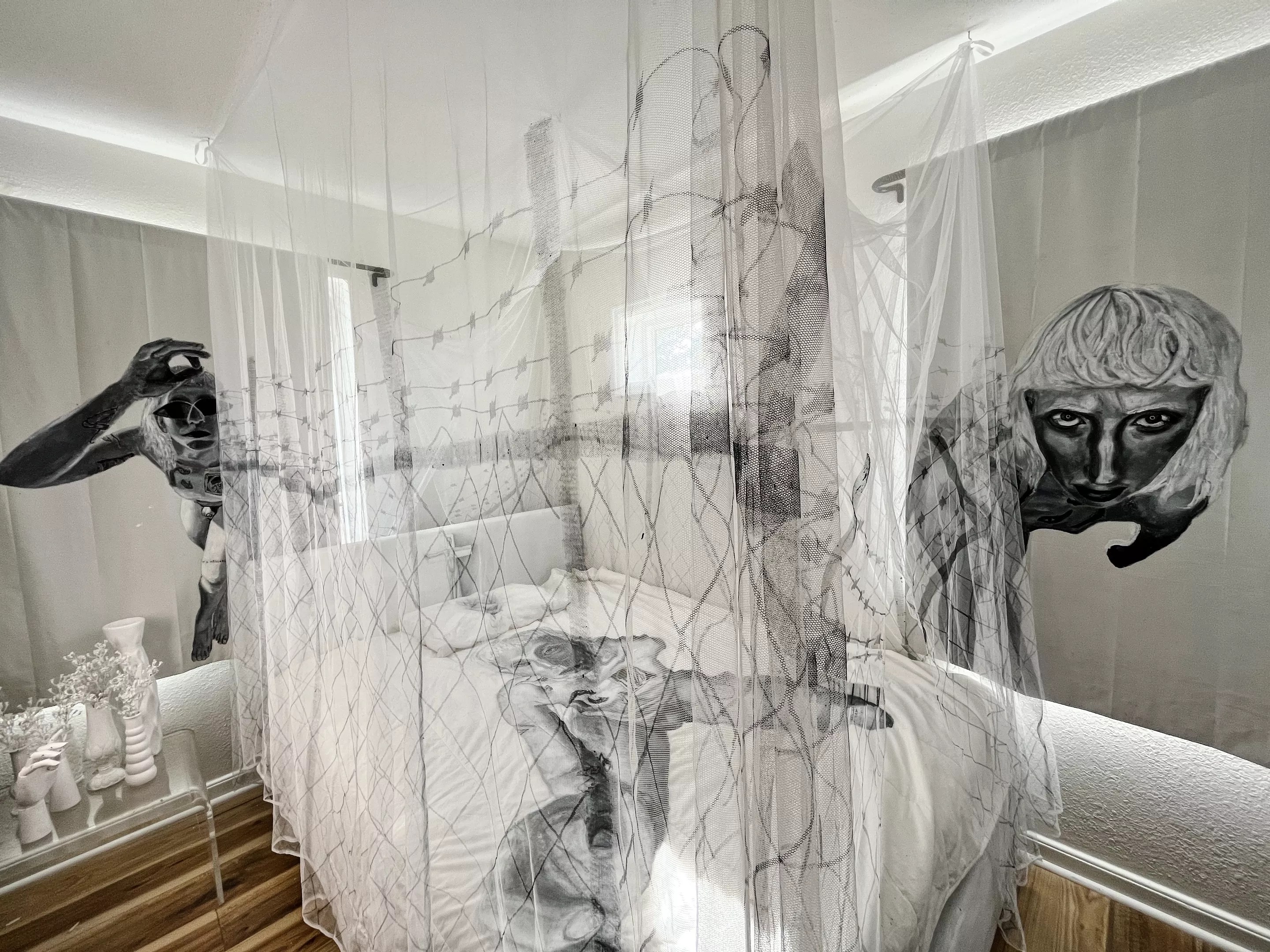
Smith’s installation, “Withdrawal.”
Courtesy Viera Smith
For the exhibit, Smith created “Withdrawal,” a ghostly, impactful installation. A bed is encircled by a netted canopy with lightly painted chain-link fencing and barbed wire; a grayscale portrait of Smith is painted on otherwise pristine white sheets, and the pillow is imprinted with the depression of a face, as if someone had buried their face in it. Drapes are painted with striking, confrontational portraits that appear to be diving from the windows into the room.
“I suffer from bipolar-1 and I’m also on HRT; estrogen really heightens the effects of bipolar to, like, not great levels. When I run out of medication, it gets really intense. So my pieces are based off of that,” Smith explains. “I took a whole room and kind of defined where my sanctuary is, which is a bed. And then the outside of the bed is the conflict; [that represents] a manic episode, where I would be pacing here, I would be laying down here, I have people looking in through the windows.”
One of Bollag-Miller’s pieces displays her own idea of sanctuary: fashion. “I’m sort of focusing on this idea of euphoric futurism and personalizing sculptural costume design with specific people’s narratives on their experiences with euphoria,” she says. “I’m using it as an opportunity to build an installation that is also wearable to create an atmosphere of sanctuary.”
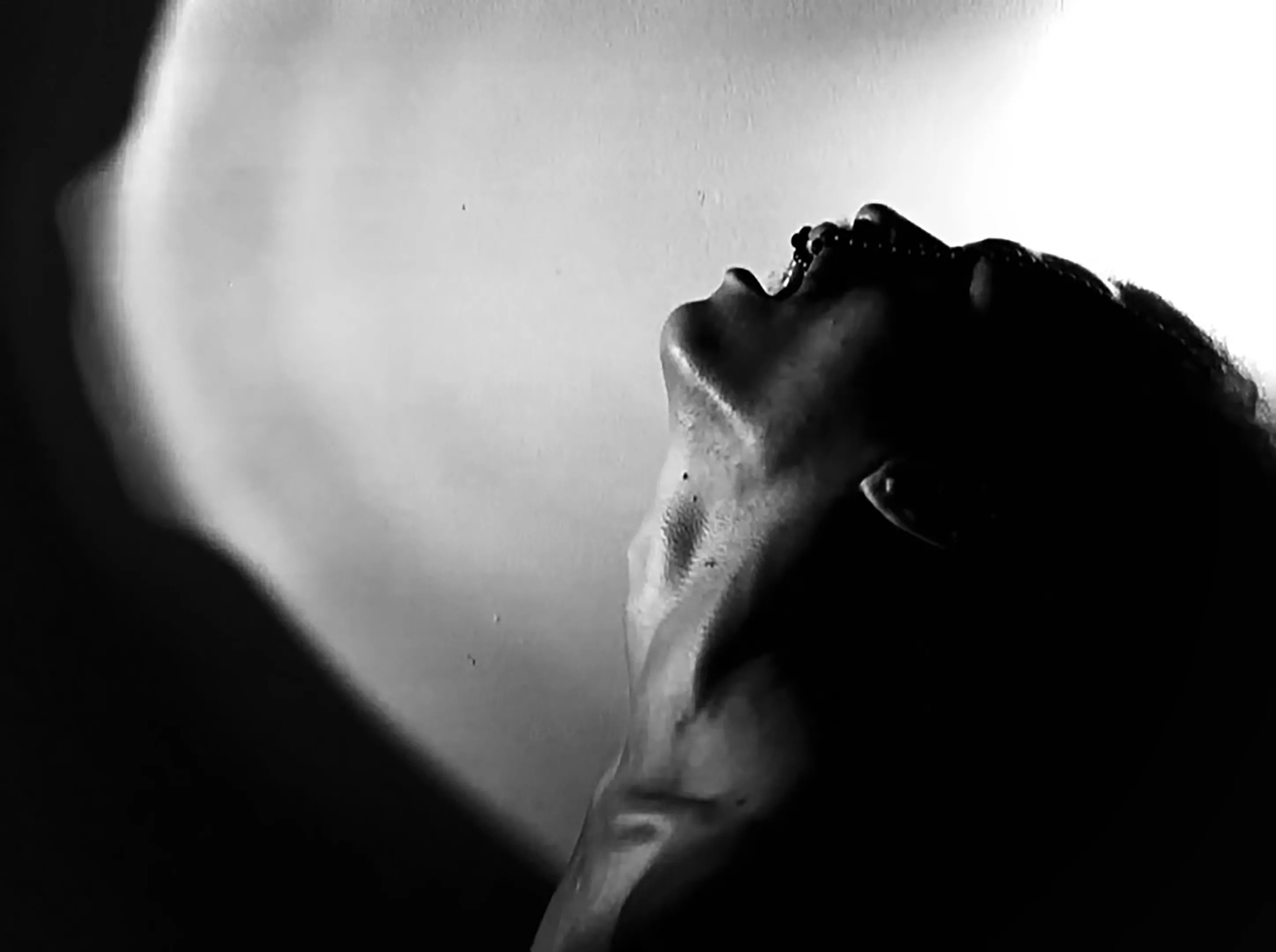
Vulvexx Summerssmith has created video installation titled “-Nightmare Film-.”
Courtesy Viera Smith
While Smith and Bollag-Miller have led the collective’s two shows, they don’t consider themselves its formal leaders; there is no one person in charge. “We always make decisions based on consensus,” Smith explains. “When we’re talking about spearheading, we’re just [doing] a lot of the logistics work, just because it was our space. We’re having it in my house right now, so I’m getting into a lot of the little tiny details, and that’s what Kit did last time for her space, as well. We do have a point person or someone to spearhead it, but we really value everyone’s opinion, and we do our best to make our decisions as a collective and by consensus.”
Because the show is confined to Smith’s home, the artists had to work with each other to decide who would utilize which space. “Everyone was so respectful of everyone else’s space,” Smith says. “For instance, we had a lot of people who really wanted to use the shed in the backyard. But we let our friend Vul use it, because it really worked with their concept.”
In the shed, artist Vulvexx Summerssmith confronts the idea of sanctuary and conflict in a moving video installation titled “-Nightmare Film-.” “It has a lot to do with their past and their trauma from growing up. Just kind of like, ‘What was my sanctuary, and where did conflict come into play? Was it really safe? Where do I go from here? How did it affect me to this day?'” Smith says. “It’s kind of a frightening piece that I thought was really, really interesting.”
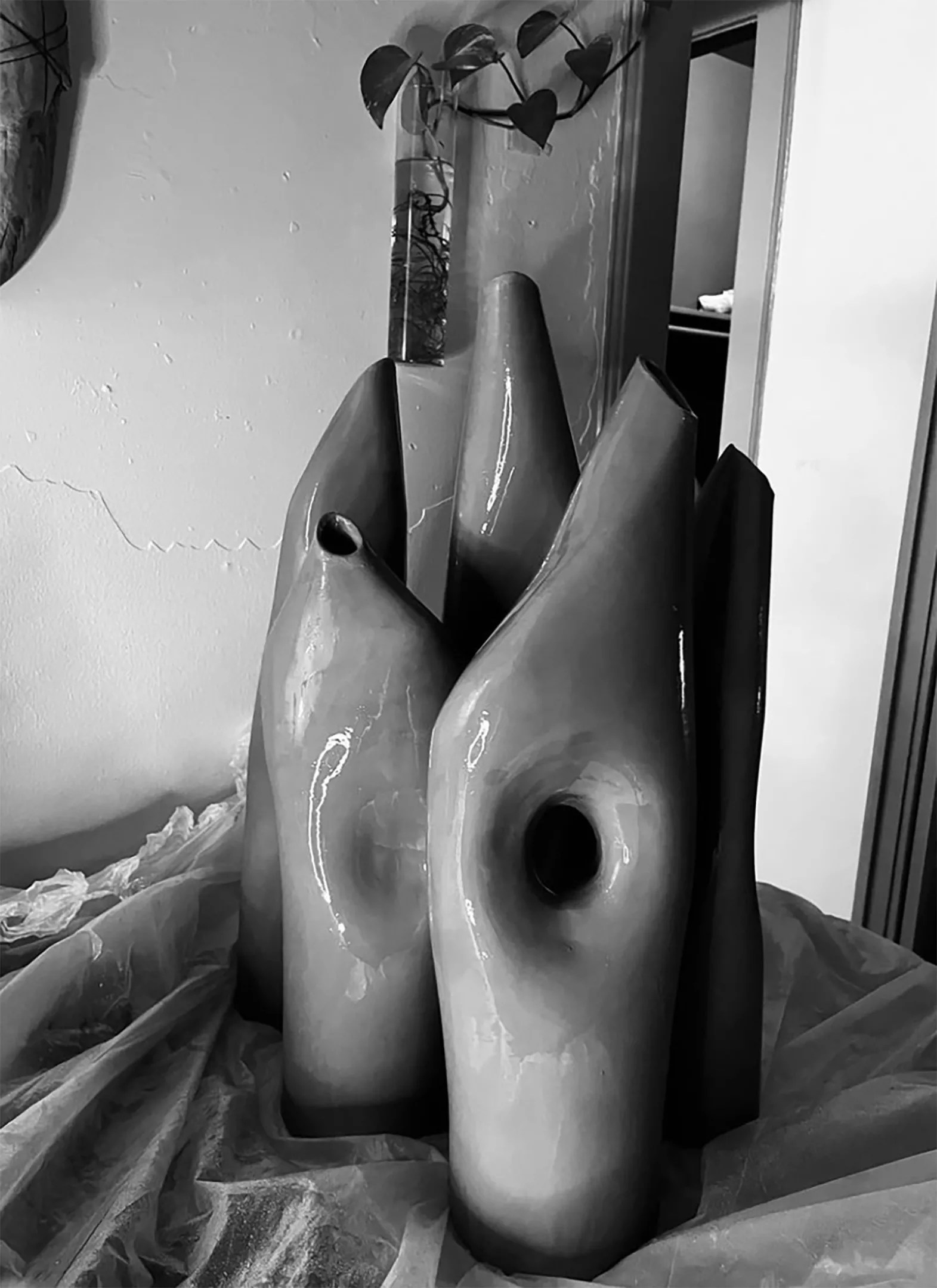
Iphis Aire has created a series of ceramics.
Courtesy Viera Smith
Artist Azul Camacho is putting their pastel work on display “with a linear story going along the walls and into another area,” Smith says. And a series of ceramics by Iphis Aire depicts a “giant progression of what it means to be queer through sculpture. They’re really taking pottery and sculpture and just queering it into something that I’ve never seen before.”
With Below the Concrete’s new show, the artists have provided a sanctuary for each other while also allowing spectators to witness their conflicts. “We’re representing ourselves,” Smith says. “We’re giving ourselves opportunities to really show who we all are as fine artists.”
Natural Tensions: Between Sanctuary and Conflict, noon to 6 p.m. Friday, October 14, through Sunday, October 16. For the address, email info@belowtheconcrete.com, or direct-message @belowtheconcrete; a $10 donation is encouraged.